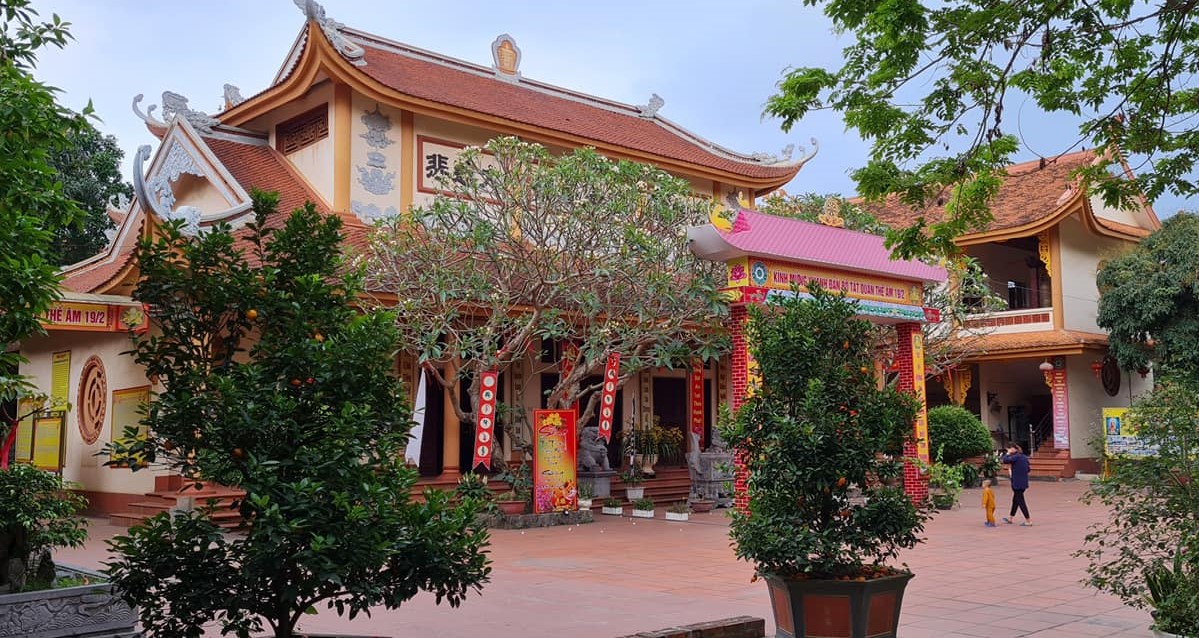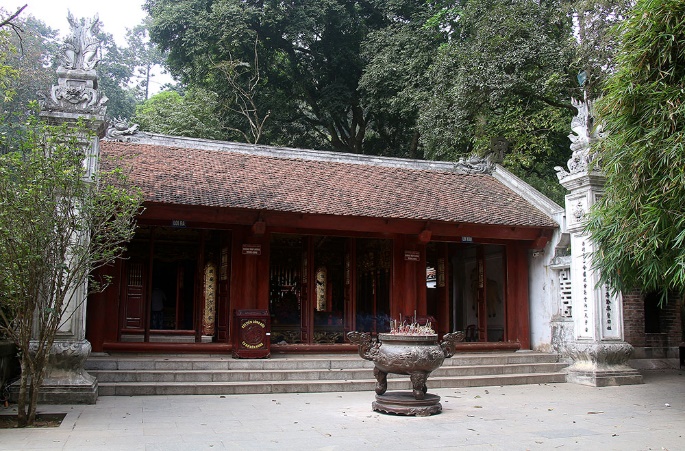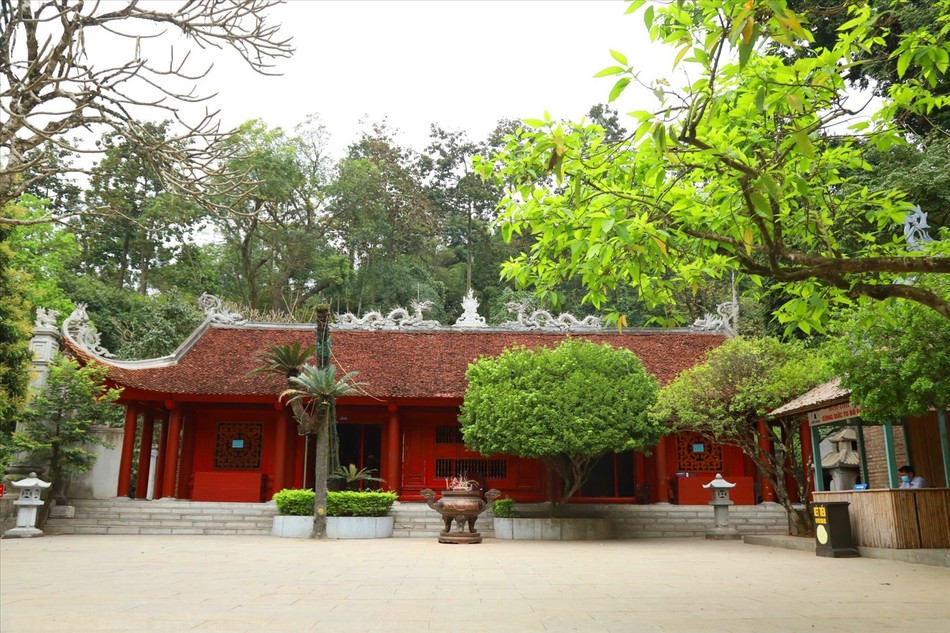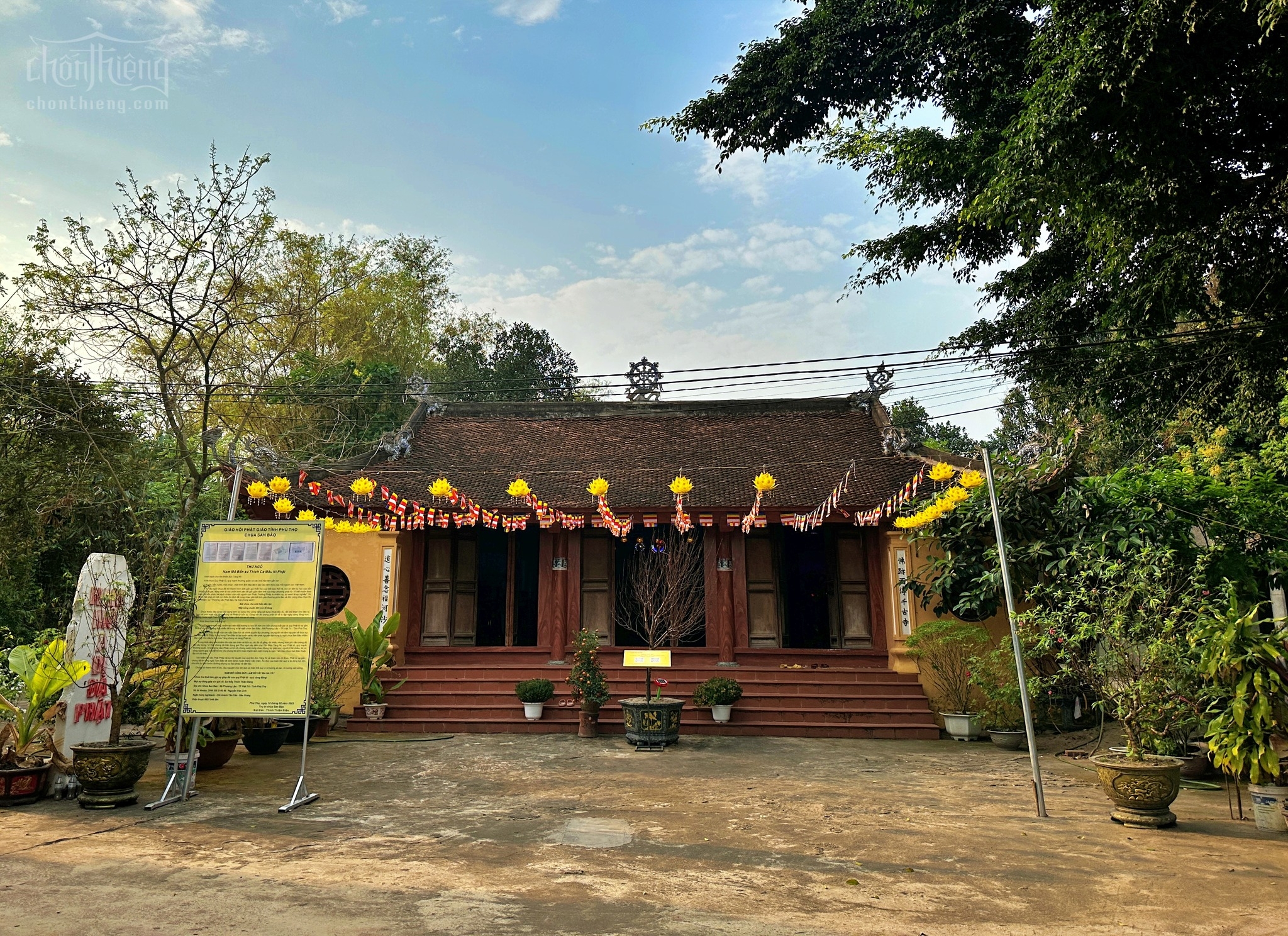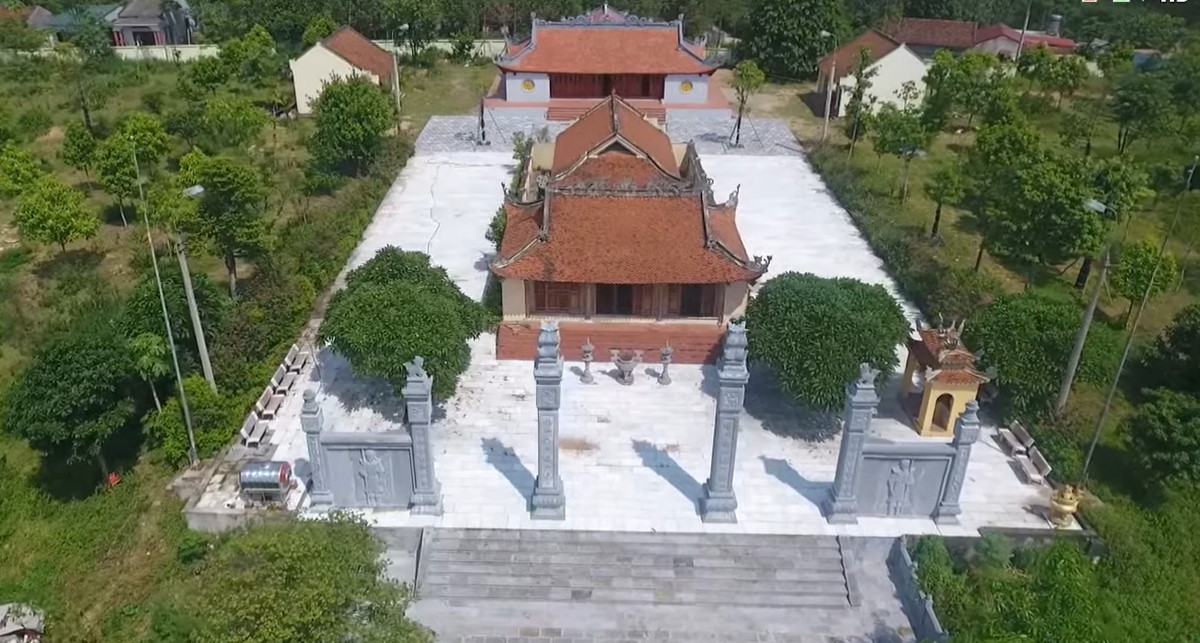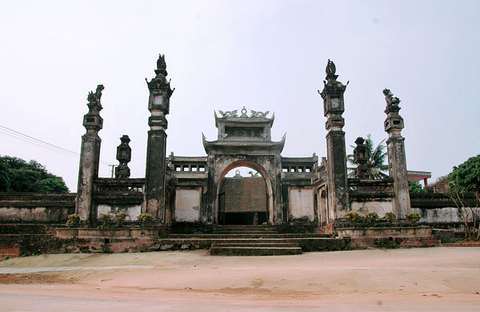Relic point Vietnam
Việt NamBao Ngan Pagoda
Bao Ngan Pagoda is located in Song Lo commune, Viet Tri city, Phu Tho province. Bao Ngan Pagoda is an ancient pagoda. Legend has it that it was originally a manor house of King Hung's daughter, and was built by the Patriarchs into a Buddhist temple, a place of spiritual warmth for the Buddhist population of the entire region. vast. Through the ups and downs of time, the temple has become a ruin. From the ancestral home of Huong Pagoda - Ha Tay, and being assigned by Buddha to Bao Ngan Pagoda, Venerable Thich Minh Thuan, step by step, persistently created both the material and spiritual foundations of the pagoda, while also developing a mind of indifference. hesitate to make efforts to contribute to the Dharma propagation industry in Phu Tho. Initially, the Master built temporary shacks, then step by step built a lecture hall, guest house, monk's house, Patriarch's house,... solid and majestic. Truong An retreats, retreats and festivals are still held here. Like bees returning to the hive, Buddhists continue to practice and study in increasing numbers. This place has become a famous Gia Lam place in the region. Bao Ngan Pagoda has architecture and interior design following Chan Tinh style combined with Mat Tinh initiates. In particular, it has a palace worshiping Patriarch Padmasambhava - an important patriarch in Tibetan Tantra. Venerable Minh Thuan, one of the outstanding Dharma disciples of Patriarch Vien Thanh, is known as the person who brought Esoteric Buddhism back to Vietnam in 1992. The architecture of Bao Ngan Pagoda follows the shape of the word "Cong", with offerings overlapping each other to form eight roofs. The harem also has twelve roofs, with a floor area larger than 500 square meters and a height of up to 16.5 meters. The pagoda now stands majestically on the banks of the Lo River, near the historic Viet Tri bridge. SOURCE: PHU THO NEWSPAPER
Phu Tho 2721 view
Thuong Temple
Thuong Temple's literal name is Kinh Thien Lanh Dien (Heaven Temple on Nghia Linh Mountain). The Temple is an architectural work of the Hung Temple complex relic site located in Co Tich village, Hy Cuong commune, Viet Tri city, Phu Tho province. Thuong Temple was built on the old foundation of the temple worshiping the mountain god, rice god, Thanh Giong..., where Hung kings often conducted rituals to pray to heaven and earth, hoping for good weather and good crops. for all people to be prosperous and happy. There are documents that suggest that Thuong Temple was built in the 15th century. The temple currently has three compartments and a curved tiled roof. The temple door has a horizontal painting: Nam Viet Trieu To (Eternal Patriarch of Vietnam), inside the temple there is a great painting: Tu Ton Bao Chi (Descendants must preserve it). There are also many couplets praising the merits of the Holy Patriarchs. The altar in the temple has tablets of 18 generations of Hung kings (Eighteenth Hung Tu Thanh Vuong Thanh Thanh) and three mountain gods: Tuot Cao Son (Nghia Linh mountain), Ap Son (Troc mountain), Vien Son (Toc mountain). On both sides in front of the temple door are two stone pillars, said to have been erected by King An Duong, swearing to forever preserve the Hung family's country and brocade. Currently, the temple has a Vuong-style architecture, built on 4 levels: Drum bell house, Great altar, Pre-worship and Harem. In the Thuong Temple, there is a great painting titled "Nam Viet Trieu To", meaning the Founder of Vietnam. The temple is made in the style of Vuong lettering, with 3 levels. In front is the ritual gate, then the grand altar (level 1), the front altar (level 2) and the harem (level 3). In the book "Hung Temple, a special national historical and cultural relic", it is written: The Ritual Gate architecture is in the style of the Nguyen Dynasty, with 4 large pillars forming 3 domed gates. The pillars above are covered in the style of lanterns, the four sides are decorated with four sacred animals, and the top of the pillar is covered with 4 lions. Above the roof of the middle gate is decorated with "two dragons flanking the sun", images of two winding dragons. On both sides there are statues of boxers, above is an image of a phoenix and a briefcase. In the grand pavilion, the front altar and the harem structure are built into 3 interconnected levels. The premises have a structure of 3 compartments and 2 rows of columns. Especially the harem is a solemn place, inside there are 4 altars. At the three front altars, there are dragon thrones and tablets placed in the altar. All are elaborately carved, painted and gilded splendidly. On the left hand side of Thuong Temple, there is a stone oath pillar, which is said to have been erected by Thuc Phan when he was enthroned by the 18th Hung King to swear to protect the country that Hung King handed over. Over time, traces of stone columns were buried. In 1968, researchers found ancient stone pillars deep underground in the Thuong Temple area. Since then, the oath stone pillar was rebuilt on the right side in front of the temple yard. In 2003, the stone column was restored to its original design; In 2009, it was renovated and embellished with semi-precious stones with the current design. SOURCE: PHU THO NEWSPAPER
Phu Tho 2834 view
Ha Temple
Ha Temple is an architectural work of the Hung Temple complex relic site located in Co Tich village, Hy Cuong commune, Viet Tri city, Phu Tho province. Legend has it that the place where Au Co's mother went into labor gave birth to a sac of a hundred eggs, which hatched into a hundred children. The origin of the Vietnamese community, the meaning "compatriot" (same bundle) originated from here.. When the children were wise Father Lac Long Quan brought 50 children to the sea to build dikes and expand the territory. Au Co's mother brought her 50 children up to the mountains to plant mulberries, raise silkworms, weave cloth, and build a life. The eldest son stayed to be the King, passed down from father to son for 18 generations, all called Hung Vuong, creating a lineage of Dragons and Fairies. The temple was built around the 17th - 18th centuries and is made of two layers in the style of Nhi; This is the place to worship the Hung Kings. Thien Quang Thien Tu Pagoda: Located to the right of Ha Temple, built in the mid-15th century. The remaining architecture today is the altar, eight-roof bell tower, beams, traps, and beautiful carvings bearing the mark of the Le Dynasty. . Next to it is a cycad tree about 700 years old. Legend has it that when Au Co's mother gave birth to a bundle of hundreds of eggs, a bright cloud shone down from the sky. Later, people built a pagoda there called Thien Quang Thien Tu (where the light from the sky shines down), in addition, the pagoda also has another name: Son Canh Thua Long Tu. The Second-style architecture includes the front hall and the back palace, each building has three compartments, 1.5 m apart. The architecture of the Ha Temple is simple, with a bridge truss throughout, with pillows attached to the end of the truss making the back roof longer than the front roof, hitched with pillars, the roof is covered with nose tiles, locally called pig nose tiles. Doc built a wall adjacent to the harem, with reliefs on both sides, one big side, one horse side. The roof is flat and has no artistic decorations. The small, level 4 temple includes 3 small rooms for worship. In front of the temple is a large stone incense burner for visitors to worship. SOURCE: PHU THO NEWSPAPER
Phu Tho 2671 view
Thien Quang Pagoda
Thien Quang Pagoda, also known as Thien Quang Thien Tu, is located in the Hung Temple cultural and historical relic site, northwest of Viet Tri city, in Hy Cuong commune, Lam Thao district, Phu Tho province. . In the Hung Temple Cultural and Historical Relic Area, this place stands near the Ha Temple, along with the Trung Temple (Hung Vuong ancestral temple), the Upper Temple (Kinh Thien Linh Dien, Cuu Trung Tien Dien), and the Well Temple, as well as the mausoleum. King Hung's tomb. The original name of the pagoda was Vien Son Co Tu, but later it was changed to Thien Quang Thien Tu. This pagoda is one of the works of the Northern sect. The construction history of Thien Quang Pagoda is closely associated with the Le Trung Hung period. The pagoda's three entrance gates are designed in the style of three compartments and two wings, simulating a stack of beds, clearly demonstrating the fine art of the Later Le period. In particular, the pagoda has an ancient bell, and in front of the pagoda yard is a three-branched cycad tree, which has existed for more than 700 years. In the pagoda, the Buddha Hall is solemn with the presence of statues of Tam The Buddha, Amitabha Tam Ton, Sakyamuni Tam Ton, Avalokiteśvara, Dharma Protector and many other Buddhas. SOURCE: PHU THO NEWSPAPER
Phu Tho 2913 view
San Bao Pagoda
San Bao Pagoda is called San Bao Tu (called by the bell), the name among the people is: Phuong Lau Pagoda (called by the relic site). The pagoda looking towards the East - South direction has an architectural layout in Cong style including 03 buildings: Tien Duong, Thieu Huong (waterpipe) and Thuong Dien with a total area of 167.4m2. The pagoda was built in the Later Le Dynasty - 18th century and was renovated and embellished in 2014 to meet the spiritual needs and Buddhist ceremonies for good deeds of people from all walks of life in the Commune as well as Buddhists everywhere. Every region has a good mind. San Bao Pagoda is the meeting place and establishment of the Chien Thang Commune Cell, which is where the soldiers in the commune are stationed. San Bao pagoda's ceremonies include: Daily chanting of Buddhist sutras, worshiping of Buddha on full moon days and first days of every month, requiem ceremonies for the souls of the dead, and other religious holidays such as: Thuong Thuong ceremony. Nguyen (full moon day in January), Trung Nguyen festival (full moon day in July). The ceremony to pray for peace in the lower fourth month of the lunar calendar, late spring and early summer is also a ceremony to eliminate pests from destroying crops. Buddha's birthday (April 15) is called the festival of Vietnamese Buddhism, with The ritual of changing Buddha's clothes. San Bao Pagoda is the only religious building in Phuong Lau commune that still preserves a system of ancient statues (37 statues) arranged in the prescribed order of statues. Research on science and history of San Bao Pagoda relics is a valuable relic of religious spirituality and has profound spiritual significance in every person. This is a relic that still preserves the inherent values in a land rich in cultural traditions, all expressed through the system of Buddha statues and the architecture of the Temple. In addition to the number of Buddha statues, the pagoda also preserves 3 stone steles (one side is a Buddha statue, the other is a stele) with typical values during the post-Le period. A bronze bell is 0.95 m high and 0.49 m in diameter. SOURCE: PHU THO NEWSPAPER
Phu Tho 2586 view
Du Yen Temple
Du Yen Temple is located in Chi Tien commune, Thanh Ba district. Here the trees are green and the rivers and mountains are charming. In front of the temple is the Thao River singing day and night, accumulating alluvium. Behind the land is like a saddle connected to Son Ngoc mound, surrounded by a lotus pond. According to records, in the early years AD in the Thao Giang area, Thanh Ba district, a good farmer family gave birth to a daughter and named her Hanh Nuong. This little girl was well educated, growing up to study both literature and martial arts. She is a smart girl who studies well, has great beauty, and has a gentle personality. When she grew up, many talented men in the village who approached her refused, not wanting to get dusty in order to keep themselves pure. In the year Hai Ba Trung rose uprising, she invited Hanh Nuong to meet her. Seeing that she was perfect in martial arts, Hai Ba Trung appointed her as the leader of the advance army. After defeating To Dinh's army, female general Hanh Nuong returned to her hometown to hold a banquet to welcome the army, reward the villagers, and hold a festival on a mound by the river in the shape of a white tiger drinking water. Later, people built a temple here and named it Du Yen (meaning a place to play and party), the day of the military year falls on the full moon day of the first lunar month. Since then, every January, the villagers hold a prayer festival to remember her merits and pray for good weather and good things for the family. Over time, Du Yen temple has degraded. People in the area have repeatedly restored and preserved the ancient temple and considered it a spiritual cultural activity spot of the whole region. Since 2003, the temple has been restored and renovated, including more than 12 items with an investment of more than 6 billion VND. In 1993, the temple was recognized by the State as a national historical relic site. SOURCE: PHU THO NEWSPAPER
Phu Tho 2531 view
Dao Xa communal house
Dao Xa communal house is located in Dao Xa commune, Thanh Thuy district, Phu Tho province. Dao Xa is an ancient land, with a long-standing culture about 1,800 years ago in Khuat Dong Lieu land, originally called Dau Village, Leather Village, later renamed Dao Xa village. The communal house's origin was built very early in the reign of Le Trung Hung (17th century). In 1924, the communal house caught fire and partially damaged its architecture. In 1930, the temple was restored and embellished. Therefore, the current architecture of Dao Xa communal house bears the mark of the Later Le and Nguyen dynasties. This place worships Hung Hai Cong (the 19th brother of King Hung), who was instrumental in opening up land, teaching people how to manage water, cultivate, raise livestock, and build prosperous villages. This place also worships three water gods, the three sons of Hung Hai Cong. Dao Xa Communal House is made in a triangular style with 3 buildings: Front altar, middle altar and rear palace. The temple's foundation is made in the style of gradually increasing towards the apse, the foundations are 0.40m higher than each other and are separated by an open-air courtyard. The architectural frame is made in the style of four pillars inside a boat; The set is structured in the style of stacking beams, gong stands, and lower sevens. With its cultural and historical values and sophisticated sculpture art, Dao Xa Communal House was recognized as a National Historical Site in 1974 and is one of the oldest communal houses in the province still preserved to this day. now. SOURCE: PHU THO NEWSPAPER
Phu Tho 2681 view
Memorial area of President Ho Chi Minh
The memorial area of President Ho Chi Minh is located on a flat land, shaded by green trees, in the middle of a charming midland countryside, in area 12, Van Xuan commune (formerly Co Tiet commune), Tam Nong district, province Phu Tho. The 2,780m2 memorial area includes works such as: welcome gate, memorial house, Mr. Hoang Van Nguyen's house - where Uncle Ho stayed from March 4 to March 17, 1947, on the way to the base. Viet Bac resistance war. The memorial house was started construction in 1994, and in 1995, it was recognized as a National Historical and Cultural Monument. The memorial area of President Ho Chi Minh in Van Xuan commune is a historical and cultural relic marking the image of Uncle Ho in the hearts of the people of the Ancestral Land of Phu Tho, and is a "red address" to educate patriotic traditions and hearts. national pride and sacred feelings of compatriots, comrades, and soldiers towards beloved Uncle Ho./. SOURCE: Central Agency of the Communist Party of Vietnam
Phu Tho 3017 view
Temple of King Ly Nam De
Temple of King Ly Nam De Located on spacious land with high terrain at Co Bong mound, Van Xuan commune, Tam Nong district, Phu Tho province, the relics of King Ly Nam De's temple includes many architectural items. such as: Ritual gate, temple, garden,... With a location not far from Hung Temple, this promises to be a unique spiritual tourist destination in Phu Tho. According to history, King Ly Nam De's real name was Ly Bi, and he was talented in literature and martial arts. From a young age, he proved to be an intelligent boy with unusual qualities. He was adopted by a Dharma Zen master and allowed him to study. Thanks to his excellent martial arts skills, Ly Bi was soon promoted to be the leader of a region. At one time, he was an official for the Luong Dynasty, but was very dissatisfied with the cruel colonial officials who exploited and oppressed the people, so he left the official position to recruit soldiers, and associated with many other talented heroes and chiefs to start a military campaign. rebellion against the Luong Dynasty's colonial rulers in Giao Chau. At the end of 541, Ly Bi officially started an army against the Liang dynasty. With the support of many people, Ly Bi's force grew stronger. In January 544, Ly Bi proclaimed himself Ly Nam De, ascended the throne, named the reign Thien Duc, established a hundred mandarins, named the country Van Xuan, and established the capital in O Dien (now Ha Mo commune, Dan Phuong, Hanoi), built Van Tho Palace as a meeting place. Relics worshiping Ly Nam De are currently scattered across the provinces: Thai Binh, Thai Nguyen, Hanoi, Vinh Phuc, Phu Tho... but only in Phu Tho is there a temple at the place where he died and a mausoleum of his family. king. SOURCE: People's Army Newspaper
Phu Tho 3011 view
Do Nghia communal house
Do Nghia communal house is located on a high mound of Do Nghia village (Son Vi commune, Lam Thao district, Phu Tho province), built around the late 17th and early 18th centuries, with typical architecture of Doai land. The communal house worships Dai Hai Long Vuong at the same time as Tan Vien Son Thanh serving the Hung Vuong dynasty. The communal house has a total area of 4,636m2, the architecture is in Dinh style. The communal house gate consists of one main door and two side doors. The main gate is arched, decorated with decorative motifs, frills, and artistic patterns. In the communal house, there are many very valuable artifacts such as: bowl-shaped palanquin (artistic decoration of the Le Dynasty in the 18th century), literary palanquin (artistic decoration of the Nguyen Dynasty), a set of halberds, 3 trays, and an embossed literary stand. A dragon flanks a moon face, a base carved with the image of a Dragon saddle, a bench decorated with holes in the shape of a dragon, a turtle, a phoenix, a jade genealogy of 16 ordinations from the Le Canh Hung to the Nguyen dynasties... As a unique artistic architectural work, an exemplary image of traditional national architectural style, Do Nghia communal house has been recognized as a national historical and cultural relic according to Decision No. 1539 dated January 27. December 1990 SOURCE: Electronic Information Portal of Ministry of Culture, Sports and Tourism
Phu Tho 2939 view
